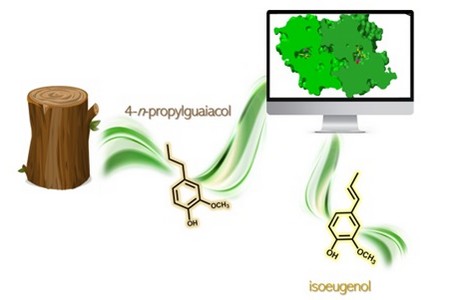Aangepast enzym maakt bouwstenen lignine bruikbaar
De chemische industrie moet verduurzamen, onder meer door bouwstenen uit olie te vervangen door groene alternatieven. Biomassa is een alternatief voor koolstof-houdende moleculen. Bovendien gebruiken we biomassa niet optimaal, want zo’n 25 procent van al het plantaardig materiaal bestaat uit lignine, een biologische polymeer die tot nu toe bijna alleen als brandstof wordt gebruikt. Een team onder leiding van enzym-ingenieur Marco Fraaije van de RUG heeft nu een enzym ontwikkeld dat een bouwsteen van lignine kan aanpassen zodat die bruikbaar is voor chemische synthese. Dit enzym is beschreven in een artikel dat op 23 november verscheen in Nature Communications.
Biomassa van planten is een aantrekkelijke bron van op koolstof gebaseerde moleculen. Maar een kwart ervan bestaat uit de biopolymeer lignine, die lastig is af te breken tot bruikbare bouwstenen. Lignine verdwijnt nu vooral in de ovens van energiecentrales. Daarom werken wetenschappers wereldwijd aan manieren om beter gebruik te maken van deze groene grondstof.

Geurstoffen
RUG-hoogleraar Marco Fraaije, hoofd van de Moleculaire Enzymologie groep, zoekt in een Europees onderzoeksproject naar waardevolle toepassingen van biomassa en kijkt daarbij nadrukkelijk naar lignine. ‘We weten dat een groep aan de universiteit van Leuven een chemisch proces heeft ontwikkeld om deze polymeer af te breken. Maar dat levert helaas monomeren op die niet goed te gebruiken zijn als chemische bouwstenen.’ Daarom gingen Fraaije en zijn collega’s in het Europese project SMARTBOX (Selective Modifications of ARomatics Through Biocatalytic Oxidations, selectieve modificatie van aromatische stoffen door bio-katalytische oxidatie) op zoek naar manieren om die monomeren aan te passen.
‘De chemische afbraak van lignine kan een aantal verschillende moleculen opleveren, en één daarvan vond ik er veelbelovend uitzien’, vertelt Fraaije. Dit monomeer heet propylguaiacol en is bijna identiek aan een grondstof voor de productie van geurstoffen. Het is een aromatisch molecuul, wat wil zeggen dat het een ringstructuur bevat. Aan de ring zit een korte staart van drie koolstofatomen. ‘Wij wilden een dubbele binding aanbrengen in die staart, zodat het molecuul beter te gebruiken is als bouwsteen. En ik kende een enzym dat dit voor elkaar zou kunnen krijgen.’
Alcohol
Maar tests lieten zien dat dit enzym niet echt goed functioneerde en bovendien het verkeerde eindproduct opleverde. Fraaije verwachtte dat dit met wat kleine aanpassingen van het enzym wel te verhelpen was. ‘Samen met een partner uit Barcelona gebruikten wij rekenkundige modellen om te voorspellen welke aanpassingen nodig waren om het enzym stabieler, selectiever en sneller te maken in het omzetten van de monomeer in een nuttige bouwsteen.’

De eerste twee stappen waren relatief snel gezet. ‘Dat is dankzij de computerberekeningen, die tegenwoordig erg betrouwbaar zijn. In het verleden hadden we een groot aantal mutanten moeten maken in de hoop dat een ervan beter zou werken.’ De stabiliteit verbeterde, waardoor het enzym enkele dagen kon blijven functioneren. Dat drukt de kosten, omdat er minder ‘vers’ enzym nodig is in het proces. Verder kon het enzym van de koolstofstaart een alkeen of een alcohol maken. Die laatste is niet goed bruikbaar, maar door te zorgen dat er geen water kon komen bij de reactie in het enzym was het mogelijk de reactie richting de vorming van alkeen te sturen.
Opschalen
Maar naast die successen was er nog wel een probleem: het enzym werkte dramatisch langzaam. ‘We hebben toen de structuur laten bepalen door colllega’s in Pavia’, vertelt Fraaije. ‘En die ontdekten dat de monomeer covalent gebonden raakt aan het enzym op de plek waar de reactie plaatsvindt.’ Covalente bindingen zijn erg sterk, dus het duurt lang voordat de aangepaste monomeer weer los komt. ‘Zo’n covalente binding tussen enzym en substraat is erg zeldzaam, maar ik had het al een keer zien gebeuren tijdens mijn eigen promotieonderzoek.’
Toen het probleem eenmaal duidelijk was, kon het relatief eenvoudig worden opgelost met nog een aanpassing van het enzym. Daarna werkte het uitstekend. Fraaije: ‘We hebben bij tests al een gram van het eindproduct gemaakt.’ Het molecuul is bruikbaar als bouwsteen voor geurstoffen, maar is ook een goed uitgangsmateriaal voor het maken van een hele reeks andere stoffen, zoals vanilline, polymeren, fijnchemicaliën of epoxyhars. Een andere partner in het EU project, de Bio Base Europe Pilot Plant in het Belgische Gent, werkt inmiddels aan het opschalen van de productie van dit aangepaste prop ylguaiacol. Daarmee zit de taak van Marco Fraaije binnen het SMARTBOX project erop. Maar hij zal ongetwijfeld weer nieuwe enzymen vinden die aangepast moeten worden.
Referentie: Yiming Guo, Laura Alvigini, Milos Trajkovic, Lur Alonso-Cotchico, Emanuele Monza, Simone Savino, Ivana Marić, Andrea Mattevi & Marco W. Fraaije: Structure- and computational-aided engineering of an oxidase to produce isoeugenol from a lignin-derived compound. Nature Communications, 23 november 2022

Meer nieuws
-
19 december 2025
Mariano Méndez ontvangt Argentijnse RAÍCES-prijs
-
18 december 2025
Waarom innoveren, en voor wie?
-
17 december 2025
Ben Feringa wint Feynmanprijs

